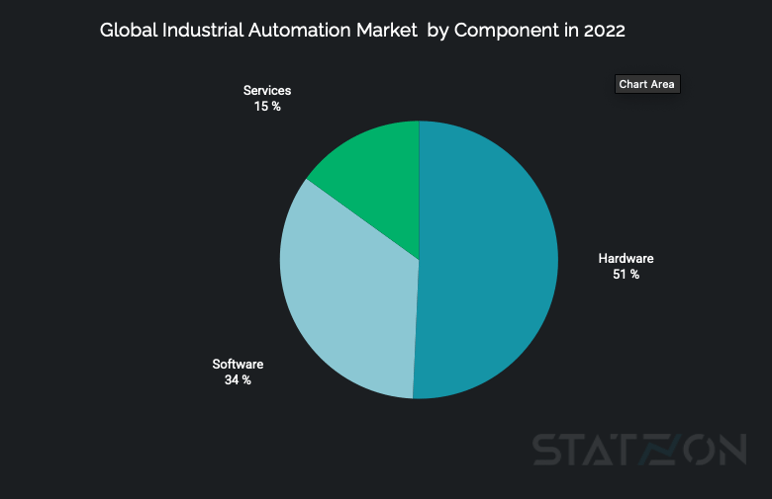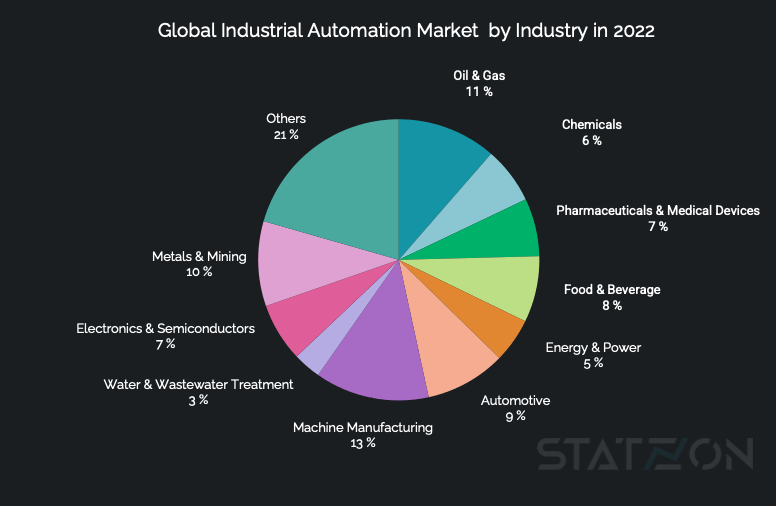The industrial automation market transforms manufacturing by integrating advanced technologies to enhance productivity, efficiency, and precision. This article provides an overview of the key segments within the industrial automation market, including robotics, sensors, mobile robots, and factory automation systems, highlighting the latest market insights and trends.
The global industrial automation market has been experiencing significant growth and is expected to continue its upward trajectory. The market is projected to reach USD 414.48 billion by 2030, growing at a compound annual growth rate (CAGR) of 10.0% from 2022 to 2030.
Key Trends
Adoption of Industry 4.0
The market is significantly influenced by the adoption of Industry 4.0 and the commercialization of next-generation networks (NGNs). These advancements are driving higher adoption rates of industrial automation services.
Collaborative Robots
Manufacturing facilities are experiencing a growing demand for collaborative robots (cobots). These robots are designed to work alongside humans, enhancing productivity and safety by integrating advanced sensors and AI technologies.
Safety Compliance and AI
Increased demand for safety compliance automation solutions and adopting emerging technologies such as artificial intelligence (AI) in industrial automation present lucrative growth opportunities.
Technological Advancements
Rapid technological changes and the adoption of new systems and networking architectures are paving the way for the interoperability of solutions, enhancing overall industrial automation capabilities.
Market Segmentation
Industrial Automation Market by Type
Fixed automation, also known as hard automation, is utilized for high-volume production processes where the product design does not frequently change. This type of automation includes machinery and equipment set up to perform specific, repetitive tasks without variation. Examples include assembly lines and certain manufacturing processes. Fixed automation systems are characterized by high initial investment costs but lower operational costs over time due to their efficiency and speed.
Programmable automation is used in batch processes where production volume is medium and can vary. This type of automation allows for changes in the product configuration, making it suitable for manufacturing different types of products. Programmable automation includes CNC machines and industrial robots that can be reprogrammed to handle various tasks. The flexibility of programmable automation allows manufacturers to respond to changing market demands and product designs.
Flexible automation is designed for production processes where products frequently change. This type of automation system can be quickly reconfigured to accommodate new product designs. Flexible automation is often used in industries requiring customization and small-batch production. This system involves advanced technologies such as collaborative robots and flexible manufacturing systems.
Fixed automation holds the largest market share, valued at USD 93.3 billion in 2022. Its projected growth rate of 9.6% CAGR will reach 194.7 billion by 2030.
 Source: Statzon / Market Research Future
Source: Statzon / Market Research Future
Industrial Automation Market by Component
Hardware components, including machines, controllers, sensors, and actuators, are essential for industrial automation. These components form the backbone of automation systems, ensuring the physical execution of tasks. The hardware market is driven by the need for reliable, durable equipment capable of operating in harsh industrial environments.
Software is a critical component of industrial automation, enabling the control and monitoring of automated processes. It includes applications for process control, data analysis, and system integration. The software market is expanding due to advancements in artificial intelligence and machine learning, which enhance the capabilities of automation systems.
Services in the industrial automation market encompass system integration, maintenance, and support services. These services ensure that automation systems operate efficiently and are updated with the latest technologies. The demand for services is increasing as companies seek to maximize the uptime and productivity of their automation investments.
Hardware is the largest segment by component, with a market value of USD 97.2 billion in 2022, expected to grow at a CAGR of 7.8% to 177.7 billion by 2030. Software and services are also significant segments, with software projected to grow at a CAGR of 13.0%
 Source: Statzon / Market Research Future
Source: Statzon / Market Research Future
Industrial Automation Market by Industry
The automotive industry is a significant adopter of industrial automation for manufacturing, assembly, and quality control processes. Automation in this sector enhances production efficiency, precision, and safety. The automotive industry continuously seeks innovations in automation to stay competitive and meet consumer demands for high-quality vehicles.
Automation in the food and beverage industry helps maintain hygiene, reduce waste, and ensure product consistency. Processes such as packaging, sorting, and quality control benefit greatly from automation, leading to increased productivity and compliance with health regulations.
The pharmaceutical industry leverages automation for processes such as drug formulation, packaging, and quality control. Automation ensures precision and compliance with stringent regulatory standards, improving the safety and efficacy of pharmaceutical products.
In the electronics and semiconductors industry, automation is crucial for handling delicate components and ensuring precision in manufacturing processes. Automation technologies such as cleanroom robots and automated inspection systems help in maintaining high standards of quality and throughput.
The automotive Industry is one of the leading adopters of industrial automation, with a market value of USD 25.9 billion in 2023 and an expected CAGR of 14.9%. Other significant industries include pharmaceuticals, food & beverages, energy & power, and electronics & semiconductors
 Source: Statzon / Market Research Future
Source: Statzon / Market Research Future
Industrial Automation Vendors
Top Companies
The market is dominated by major players such as ABB, Siemens, Emerson, Rockwell Automation, Honeywell Process Solutions, and Schneider Electric. These companies focus on expanding their product portfolios, enhancing services, and forming strategic partnerships to maintain competitive advantage.
Strategic Initiatives
Companies focus on technology innovation, expanding high-value services, and entering new markets to drive growth. For example, ABB’s strategic initiatives include focusing on microgrids and food & beverages sectors, particularly in Africa.
Robotics in Industrial Automation
Industrial Robots
Industrial robots are integral to modern manufacturing processes. The global industrial robotics market is experiencing robust growth, driven by the increasing adoption of automation across various industries. The market is projected to grow from USD 14.9 billion in 2022 to USD 30.5 billion by 2030, at a CAGR of 9.39%. Collaborative robots (cobots), which can safely operate alongside human workers, are particularly noteworthy for enhancing productivity without extensive safety measures.
Service Robots
Service robots are gaining prominence in sectors such as healthcare and hospitality. These robots address staff shortages and improve operational efficiency. For instance, service robots in Japanese care homes assist with routine tasks like lifting and transporting residents and monitoring for falls or emergencies. The global service robotics market is expected to grow from USD 40.7 billion in 2023 to USD 297 billion by 2033, at a CAGR of 22.05%.
Robotic Sensors
Robotic sensors enable robots to perceive their environment and perform precise actions. These sensors are used in various applications, including positioning and navigation, quality control, safety, assembly, and environment monitoring. The global market for robotic sensors was valued at approximately USD 1.9 billion in 2023 and is projected to reach USD 4.9 billion by 2033, growing at a CAGR of 10.35%.
Mobile Robots
Mobile robots, including Automated Guided Vehicles (AGVs) and Autonomous Mobile Robots (AMRs), play a vital role in industrial automation. These robots are extensively used in logistics and warehouse automation to transport goods efficiently. The global mobile robot market was valued at USD 4.2 billion in 2023 and is projected to reach USD 8.8 billion by 2033, growing at a CAGR of 7.9%.
Factory Automation
Factory automation systems integrate various technologies to streamline manufacturing processes, improve productivity, and reduce operational costs. The global factory automation market is projected to grow significantly, driven by the need for increased efficiency and resilience in manufacturing. At the end of 2023, the market was USD 140.5 billion, and it is forecasted to grow to USD 281.9 billion by 2030, registering a CAGR of 9.1% during the forecast period 2022-2030.

Sources: Statzon, McKinsey, McKinsey (2)





